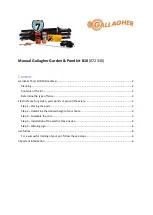
Section 2: S530 site preparation and installation
S530 Parametric Test System Administrative Guide
2-18
S530-924-01 Rev. D / September 2017
System power dissipation
The total power dissipated by the S530 depends on the type and number of instruments in the test
system. The power distribution unit (PDU) limits the incoming power to these instruments. Though the
PDU ensures electrical safety and compliance to the required standards, it does not prevent the
system from overheating.
When a Series 2600B instrument detects an excessive heat condition, the instrument turns the output
off to minimize power dissipation. This safeguard prevents damage to individual Series 2600B
instruments, but may result in test instability. For instance, if you continuously source more than 1 A
from all the source-measure units (SMUs) for more than 100 seconds, it may trigger a temperature
error in one or more of the Series 2600B instruments. However, an average output of less than 1 A
for an indefinite period will not cause a temperature error.
For additional information about the Keithley Instruments Series 2600B SourceMeter
®
instruments,
refer to the documentation on the CD-ROM that was shipped with your purchase.
Operating environment conditions
The S530 will not perform within specifications if operated outside of the following environmental
conditions.
Temperature
: 23 °C ±5 °C (73.4 °F ±9 °F).
Operating humidity
: 30% to 60% relative humidity, noncondensing, after a two-hour warm up time.
Vibration
: High ambient vibration levels may require isolation pads or the repositioning of equipment.
Air quality
: The S530 system is compatible for use in a Class 10 clean room.
Audible system noise
: Decibel level is 65 dBA in optimal environmental conditions.
Airflow
: The S530 system is configured for top to bottom airflow.
Altitude
: Less than 2000 m (6,561 feet) above sea level.
Noise interference
: To prevent electrical noise from interfering with measurements, the ambient AC
magnetic field must not exceed 2 × 10
-3
G (2 × 10
-7
T).
Avoid locating the S530 next to plasma etchers, large motors, magnets, RF transmitters,
equipment with flash lamps, and other potential sources of interference.
Position equipment to avoid routing signal and power cables near sources of electrical noise.
Triaxial connector handling and avoiding contamination
Keep source-measure triaxial cable connectors (if applicable) clean and free of any foreign
contaminants. Do not touch the connector pins of the triaxial connectors. Contamination can cause
current leakage in the source-measure signal paths to the device under test (DUT), which can
significantly degrade the test results.
Do not touch any connector pins or the areas adjacent to the electrical contacts of the triaxial
connectors; contamination will degrade the performance of the test system.
Cleaning
: Using lint-free swabs, clean contaminated connectors with methanol or isopropyl alcohol,
and then blow-dry them with nitrogen gas. After blowing dry, wait several minutes before using.
















































